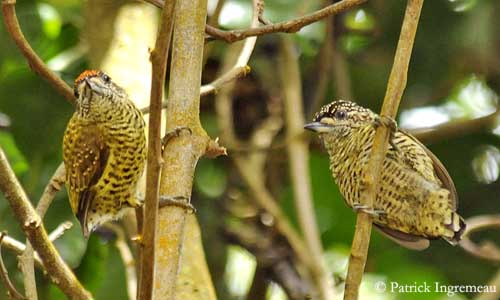

FAMILY PICIDAE
Woodpeckers, Piculets and Wrynecks
The Picidae Family belongs to the Order Piciformes. This family gathers Woodpeckers, Sapsuckers, Flickers, but also Wrynecks and Piculets.
Woodpeckers form the most important part of this family.
Picidae are widespread through the world, except in Madagascar, New Zealand, Australia and the poles.
The typical morphology features of this family include a strong, straight bill, a reinforced skull, short legs and strong feet for climbing, and stiff tail feathers. They have a very long tongue, adapted to their feeding habits.
The straight, chisel-like bill is made for excavating holes in tree trunks, and the reinforced skull is able to support repeated pecks against the wood.
Short legs, strong feet and stiff tail feathers allow the birds to climb vertically and laterally along trunks and branches.
The long, sticky tongue allows to probe deeply in bark crevices, in order to reach invertebrates and concealed larvae.

Woodpeckers regularly perform drumming. Both sexes drum, but mainly the male. Drums are closely related to territorial behaviour, as advertising calls in other bird’s species.
The Woodpecker’s voice allows them to utter rattling calls and screams.
Woodpeckers are mainly arboreal species and usually frequent wooded habitats which provide them suitable nest-sites because they are cavity nesters.
They breed in tree holes. Both sexes excavate the cavity, thanks to the strong bill. The nest chamber is lined with some wood chips, and the hole is often pear-shaped.
Both sexes share the nesting duties. The clutch usually consists of 2 to 5 white eggs. Incubation lasts about 11 to 15 days, by both parents, the male mainly at night. The young leave the nest at about 3 to 4 weeks of age.
Woodpeckers feed mainly on insects and larvae, other arthropods and caterpillars. They also consume nuts, fruits and tree sap. They reach the larvae thanks to their straight bill which excavates the crevices, searching for wood-boring insects.
Woodpeckers are good fliers, performing undulating flight, and most of them are sedentary in their range.
The Wryneck belongs to the Picidae Family, but its behaviour is slightly different. This bird does not drum, and it has not stiff tail feathers. It does not excavate tree holes, and prefers to use abandoned or occupied cavities, from which it ejects eggs and nestlings before to adopt the hole. It is territorial and defends strongly the nest-site.
Woodpeckers are threatened by deforestation and habitat loss. They are vulnerable to indirect poisoning when they feed on ants or fruits in orchards, but their populations are usually secure, even if the two biggest woodpeckers are now extinct since the last century. At this moment, about 215 species are conserved in the Picidae Family.
Photographers:
Patrick Ingremeau
TAMANDUA
Philippe Wolfer
OISEAUX D’ARGENTINE
Nicole Bouglouan
PHOTOGRAPHIC RAMBLE
Text by Nicole Bouglouan
Sources:
HANDBOOK OF THE BIRDS OF THE WORLD Vol. 7 by Josep del Hoyo-Andrew Elliott-Jordi Sargatal – Lynx Edicions – ISBN: 8487334377
L’ENCYCLOPEDIE MONDIALE DES OISEAUX - Dr Christopher M. Perrins - BORDAS - ISBN: 2040185607


Picus viridis
The Piculets are smaller than the other members of the family with less than 10 centimetres long.
They differ in size, but also in the use of the tail when moving in the forest. They have a short tail with slightly pointed rectrices.
While they are moving along the thin branches, or hammering strongly, the tail is only rarely used as support.
They have soft-coloured plumage, often brown to greenish with black markings. As in woodpeckers, the head pattern, orange or red in males and often white in females, makes the difference between the sexes.

They are able to excavate the nesting hole, thanks to the pointed bill laterally compressed.
Some species drum, and drumming can be regularly heard from these small birds.
The Piculets live in a wide variety of forested areas and woodlands such as rainforest or dry woodlands, plantations, mangroves, gallery forest, according to the range.
The most part of the Piculets is found in South America, but one species occurs in Africa, south of the Sahara, and some others are found in SE Asia to Java and Sumatra.

White-barred Piculet
Picumnus cirratus
Their diet is relatively similar to that of woodpeckers, especially for the invertebrates, with boring insects and their larvae, caterpillars and spiders.
There is not information about their feeding behaviour, but some of them, better known, forage at various levels in forest. They are very agile and rapid, and can reach the tip of the thin branches.

White-barred Piculet
Picumnus cirratus
The Piculets nest in holes excavated by both sexes. Some displays are observed with the male circling around the female, and chasing her among the branches. Some other displays include wing-spreading and synchronized movements.
The brood ranges between 2 and 4 eggs. Both adults share the nesting duties. They defend the site and can peck at the intruders.
Most of the species seems to be resident in the range, and they are not globally threatened at this moment.
But these birds still are poorly known.

Jynx torquilla